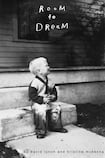
Both biography and memoir of David Lynch, Room to Dream is a book of dualities. This is apt because Lynch's body of work (spanning painting, photography, film and music) is also full of dualities: lightness and dark, love and violence, factory and nature . . . And between Kristine McKenna's biography and Lynch's vivid memory ("a conversation with his own biography") lies the duality of fact and memory. Treading the lines of these dualities, the reader discovers a remarkable life.
The structure is thus: McKenna provides, in one chapter, the facts of a particular period of Lynch’s life. Her woven-together testimony is comprehensive and insightful, with full, committed access to those around Lynch throughout his life. Lynch then responds to the chapter – its facts, figures, memories and critiques – sometimes rejecting versions of events, or failing to remember them, sometimes expanding, or filling in, or philosophising, or digressing. His voice is a joy, clear and distinctly Lynch, full of the 1950s gusto – “peachy keen!” – he is known for, but also thoughtful, and sometimes angry. His anecdotes are a riot, and can only be described as Lynchian. Marlon Brando turns up at his house in drag, demanding to make a film with Harry Dean Stanton, the film being about the two of them taking tea . . . in drag. The first time he gets high he ends up in someone’s front room, sitting over a dismantled motorbike, seeing the face of Nancy Briggs in a pool of water in his hands.
McKenna's chapters start with childhood and teenagehood, and then walk through Lynch's CV as a creative artist (and from his discovery of Transcendental Meditation to his TM foundation). The reader hears from Lynch's colleagues, critics, relatives, friends and lovers. McKenna also offers succinct, finely judged appraisals of his work (in all codes). His genius, she affirms, "is his ability to burrow into the microcosm", finding "the mystical and surreal in the tiniest aspects of everyday life". She brilliantly deconstructs Lynch's America as a realm of "fluid logic", "a river that flows ever forward, carrying odds and ends from one decade to the next, where they intermingle and blur". Certainly Blue Velvet and Twin Peaks occur in "indeterminate [American] periods where time has collapsed in on itself".
Workshop ethic
Lynch is remembered by his childhood friends as an inherently good, funny kid, who customised T-shirts for neighbours and built subterranean forts with his pals. His parents were endlessly supportive, taking their children’s creative ideas “absolutely seriously”. They kept a workshop where ideas “got made”, and, sensing his creative drive, Lynch’s mother banned colouring books, believing they’d limit the free-thinking of his obsessive drawing. This workshop ethic and freedom from structure has resonated through Lynch’s working life.
Indeed, it's fascinating and addictive to chart how incidents from Lynch's life have permeated his creative output. The scene in Blue Velvet in which Dorothy Vallens walks the street naked and abused was something Lynch witnessed in an awful episode as a child. Likewise, Lynch saw the Twin Peaks "smiling bags of death" in a morgue in Philadelphia, decades before the show was conceived. Lynch's tonal dualities are all there in his life story, from the euphoric 1950s chrome optimism to the abandoned factory and the atom bomb.
Lynch’s method is pure and singular, thriving on goodwill, happenstance and its own sense of self. He is not trying to fit into a space, or conform to a style; he is dreaming each piece into existence, then letting it holler and scream and sing as it must. Most of the actors he has worked with profess him to be the best and kindest director (and employer) they’ve encountered. His sets are notorious for magic and happiness. The word “genius” abounds. It is intriguing to read how he directs his actors, once telling Russ Tamblyn to forget about the words spoken and just “think about ghosts”. He sometimes even directs without words, with only looks.
Artist’s responsibility
As a memoir and a study, Room to Dream is a marvel. But it does provoke questions of the artist's responsibility, on both a societal and a personal scale. Lynch's dedication to "the art life" (the subject of a recent documentary) is admirable, but comes at a cost. Lynch's personal relationships have often been sacrificed. Each of his wives speaks very positively about Lynch as a compassionate (though often distant) companion and parent, but it becomes clear that he has always put art before family. In his own words: "I always felt that the work was the main thing." Or, to quote his response when Emily Stofle (his current wife) told him she wanted children: "I have to do my work and I don't want to be made to feel guilty." In a tragic early episode, Mary Fisk suffers a miscarriage, and while she undergoes medical treatment Lynch remains on location, coming up with a new project '"to relax himself". McKenna's chapter moves swiftly on.
While these were consenting scenarios, and Lynch is only expressing his priority, I felt uncomfortable reading this. As a creative artist, I've always stressed the view that an artist (in any mode) must treat their work like a trade, with the same disciplined, down-to-earth approach as an apprentice plumber. I baulked when, in this paper, John Banville seemed to accept that writers made bad fathers. But no matter how consenting the concerned parties, or how upfront the artist is about their priorities, should "the art life" be treated as an exemption from the responsibilities of a partner or parent? The question is provoked by the reading of this fine book, but it is not the book's responsibility to answer it. And, ultimately, Room to Dream does provoke wonder, and advocate dreaming, and further questioning, as all of Lynch's best artistic work does.











